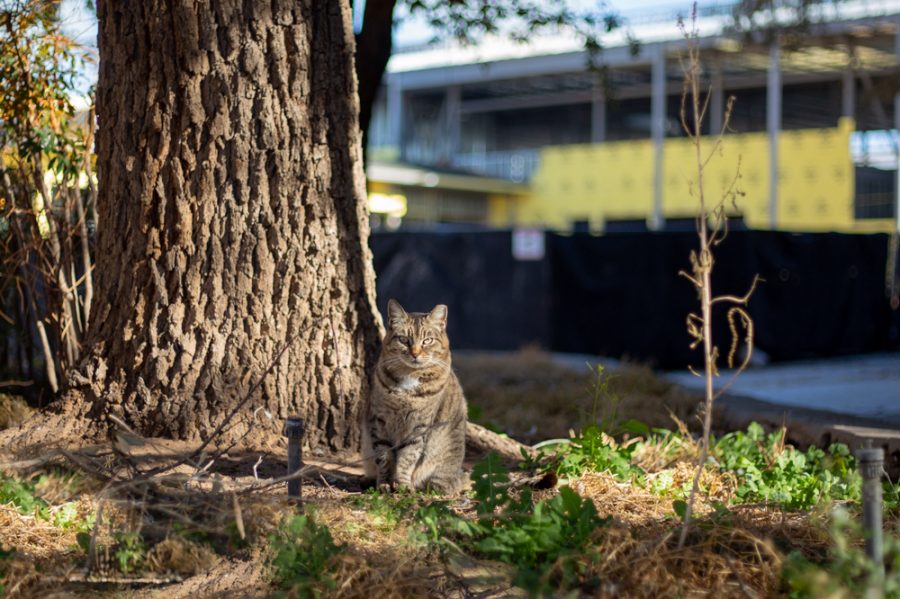NMSU organization decreases feral cat population on campus

More stories from Marianne Salas
The feral cat population on the NMSU campus has decreased from around 250 to 40 since 2002.
New Mexico State University’s feral cat population, while still present, has decreased tremendously since the founding of the Feral Cat Management Program (FCaMP) in the spring of 2002.
Beginning with a staff of four individuals and little funding, FCaMP managed to reduce the number of feral cats on-campus from an estimated 200 to 250 down to 40 near the program’s end in December 2017.
Michelle Corella, FCaMP’s former director, stated that prior to FCaMP, NMSU groundskeepers were tasked with periodically trapping as many feral cats as possible. The cats were then taken to animal shelters and euthanized. Despite efforts, the numbers never seemed to drop.
“This is due to a phenomenon known as the vacuum effect. When animals are removed from a population, producing animals still intact will begin breeding to make up for that loss,” Corella said.
Instead, FCaMP insisted on a Trap-Neuter-Return policy, a process by which feral cats are captured, spayed or neutered, and then released back onto campus to live out the rest of their lives.
Through FCaMP, feral cats were also vaccinated and microchipped, with their left ears being tipped to indicate that they had already undergone the TNR procedure.
Partnering with Calista Animal Hospital, whose staff performed a majority of the surgeries, FCaMP has successfully spayed or neutered over 350 feral cats since its implementation in 2002.
“TNR involves not only trapping cats and placing them back, but also consists of taking any kittens, socializing them, and finding homes,” Corella said. “The same is also done for any lost or abandoned cats that are tame.”
Feral cats appear no different from a typical house cat. At some point in time, however, they or their predecessors were abandoned or left outside. They likely never came into contact with humans, and eventually began to fear them.
Corella said people should not try to domesticate feral cats if they see one.
“People who don’t understand feral cats think that they can just be picked up and put into a house where they’ll be fine. This isn’t true. They’re miserable, and they don’t belong indoors,” Corella said.
The issue with feral cats is further complicated when discussions of diseases are involved. While spaying or neutering feral cats prevents them from reproducing, feral cats are also known to carry Feline Leukemia Virus and Feline Immunodeficiency Virus. Both are incurable and can be transmitted through the sharing of water bowls or through fighting from the wounds.
A source familiar with the feral cat population on-campus said that though it helps to spay or neuter feral cats, they should also be tested and vaccinated if they do not have either disease.
The source indicated that if they test positive, the cat should either be euthanized or placed into a single cat home to live out the remainder of its life, an option not suitable for most feral cats.
While FCaMP vaccinates its felines that do not test positive, the procedure is not required by law, and is often done at an additional cost by clinics and shelters to spaying or neutering. Because vaccinations can be costly, individuals that bring in feral cats may be unwilling to pay the additional fees.
Resources are provided on FCaMP’s website regarding links to other TNR programs and feline adoptions at http://www.fcamp.nmsu.edu.

Marianne Salas is a senior at NMSU pursuing a double-major in English and Government with a supplementary major in Law & Society. She will be attending...


Jan Isherwood • Oct 9, 2019 at 8:23 AM
This is a moot point because caretaking of a cat colony absolutely involves getting All the kittens adopted, after spaying and neutering them as well to insure no more breeding. There can then be no increase in the colony size. The bottom line to TNR success, is that you have get All the cats “fixed!” ASAP- You can’t even leave one cat fertile or you will be starting all over again- sooner than you think! Kittens are cute, they’re wonderful, but get them adopted QUIK- before : 1. They get sick, and 2. So you can help Others who WILL need your help!
Yvretta Carus • Jan 24, 2019 at 4:40 PM
If the vacuum effect is real, then NMSU is wasting effort on recruiting new students. Vacuum theory predicts that if a student graduates or drops out, another student takes his place.